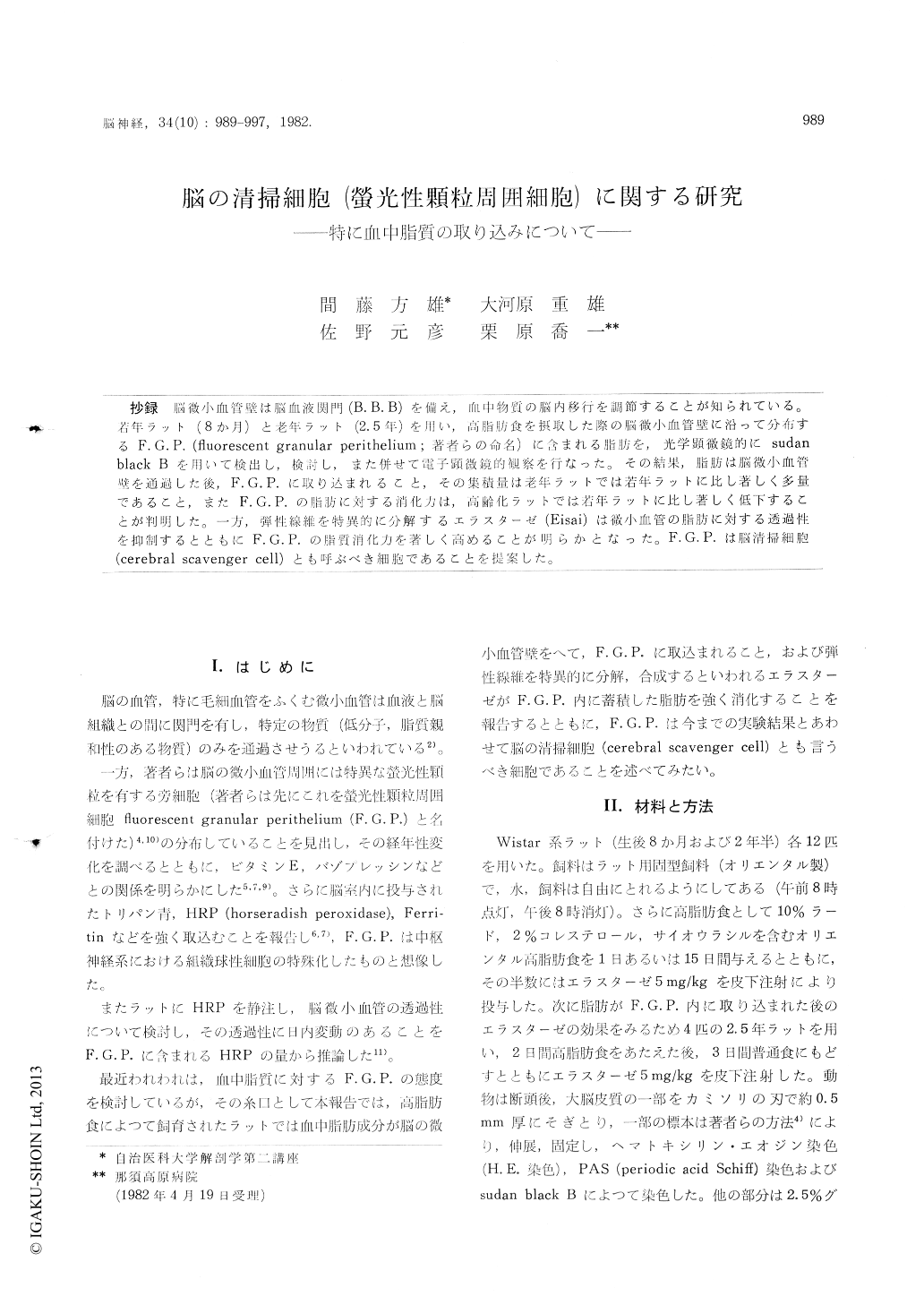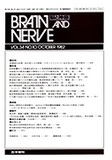Japanese
English
- 有料閲覧
- Abstract 文献概要
- 1ページ目 Look Inside
抄録 脳微小血管壁は脳血液関門(B.B.B)を備え,血中物質の脳内移行調節することが知られている。若年ラット(8か月)と老年ラット(2.5年)を用い,高脂肪食を摂取した際の脳微小血管壁に沿って分布するF.G.P.(fluorescent granular perithelium;著者らの命名)に含まれる脂肪を,光学顕微鏡的にsudanblack Bを用いて検出し,検討し,また併せて電子顕微鏡的観察を行なった。その結果,脂肪は脳微小血管壁を通過した後,F.G.P.に取り込まれること,その集積量は老年ラットでは若年ラットに比し著しく多量であること,またF.G.P.の脂肪に対する消化力は,高齢化ラットでは若年ラットに比し著しく低下することが判明した。一方,弾性線維を特異的に分解するエラスターゼ(Eisai)は微小血管の脂肪に対する透過性を抑制するとともにF.G.P.の脂質消化力を著しく高めることが明らかとなった。F.G.P.は脳清掃細胞(cerebral scavenger cell)とも呼ぶべき細胞であることを提案した。
Small cerebral vessels including capillaries are provided with the specific barrier (blood brain barrier) for a transport of substances from blocd to cerebral tissue. However, it is also established that fat soluble substances are easily permeable in this barrier.
Along cerebral small vessels, the cells having intracellular fluorescent granules are distributed and named "fluorescent granular perithelia (F. C. P.)" by the authors. They are potent in the uptake capacity for exogenous substances as reported in the previous papers.
In this study, 24 male Wistar rats aged 8 months and 2. 5 years old were employed. They were fed with a fat rich chow (Oriental Co.) containing 10% lard, 2% cholesterol and methylthiouracil for one day and fifteen days. Half of them was subcutaneously injected with 5 mg/kg of elastase (Eisai Co.) dissolved in physiological saline once a day. To clarify the effect of elastase on fat incorporated by F. C. P., 4 rats aged 2. 5 years were fed with a fat rich chow for 2 days. After then, they were fed with ordinal rat chow for 3 days with or without elastase injection.
After decapitation, cerebral cortex of rats was removed in cold physiological saline and sliced with a blade. Half of the sliced specimens was prepared by the authors' method (Mato and Ookawara, 1979) and stained with hematoxylin eosin, periodic acid Schiff reaction and sudan black B for a light microscopical observation. The other half of the specimens was immersed ina mixture containing 2 % paraformaldehyde and 2.5% glutaraldehyde buffered with 0.1 M pho-sphate solution (pH 7. 4) for 10 h. The specimens were then postfixed with osmium tetroxide buffered with the same solution for 2 h. The other procedures for embedding and cutting were the same as in a routine method.
Following findings were obtained at the light and electron microscopical levels ; when they were fed with a fat rich chow, fat in blood passed through vascular walls and was taken up by F. G. P.. The quantity of fatty deposits in F. G. P. was different depending on age of rats employed for the experiment. The deposits in F. G. P. increased with advancing of age. That is, in old rats a lot of deposits were chieflydistributed in inclusion bodies at one and fifteen days after the administration. The difference in quantity of deposits between young and old rats was not only based on the permeability of vessels, but on the digestion capacity of F. G. P. for fat.
On the other hand, Elastase, a specific enzyme for lysis and synthesis of elastic components, prepared by Eisai Co., made a suppressive effect to the permeability of cerebral small vessels and facilitated markedly the digestion capacity of F. G. P. for fat, although the mechanism remained unsettled.
From this standpoint, F. G. P. are also designa-ted as "cerebral scavenger cells ".

Copyright © 1982, Igaku-Shoin Ltd. All rights reserved.


